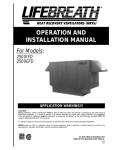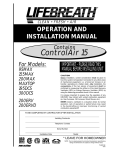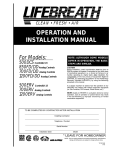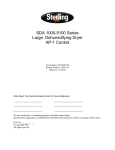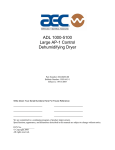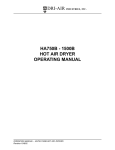Download American Aldes HRV 1500 SFD Installation manual
Transcript
AAV1534 OPERATION AND INSTALLATION MANUAL For Models: For Models: HRV 1500 IFD HRV 1500 SFD HRV 1500 EFD HRV 1500 SFDE NOTE: ALTHOUGH SOME MODELS DIFFER IN OPERATION, THE BASIC INSTALLATION STEPS ARE SIMILAR. APPLICATION WARNING !!! It is always important to assess how the operation of any Heat Recovery Ventilator may interact with vented combustion equipment (i.e., Gas Furnaces, Oil Furnaces, Wood Stoves, etc.) NEVER install an Heat Recovery Ventilator in a situation where the normal operation (including defrost function), lack of operation or partial failure may result in the backdrafting or improper functioning of vented combustion equipment!! TO BE COMPLETED BY CONTRACTOR AFTER INSTALLATION a ___________________________________________________________________ Installing Contractor ___________________________________________________________________ Telephone / Contact ___________________________________________________________________ Serial Number _______________________________ Installation Date _________________________________ Model Do Not Attempt Installing Unit Without First Reading Entire Manual Note: Due to ongoing research and product development, specifications, ratings and dimensions are subject to change with notice AL-04 9806 aav#1534 INTRODUCTION TABLE OF CONTENTS GENERAL This Heat Recovery Ventilator (HRV) is designed to provide fresh air into the building while exhausting an equal amount of stale air. During the winter months, the incoming cold fresh air is warmed by utilizing the heat recovered from the stale air before it is exhausted to the outdoors. During summer months when the indoor space is air conditioned, the Heat Recovery Ventilator will help in cooling the incoming fresh air with the stale air that is being exhausted. Cover & Installation Information...................... 1 These instructions are intended as a general guide and do not supercede local codes in any way. Consult authorities who have jurisdiction before installing. Roof Curb Assembly Instructions ................... 9 General ......................................................... 2 Engineering Data ........................................ 3-4 Function and Controls ................................... 5 Additional Features ....................................... 6 Servicing ....................................................... 7 Mounting the 1500 ......................................... 8 Roof Curb Detail ......................................... 10 Ducting ................................................... 11-12 The Integrated HVAC System ........................ 13 Pitot Tube Air Flow Balancing ........................ 14 Wiring Diagram .............................................15 Warranty ........................................................16 LEAVE WITH EQUIPMENT Note: Due to ongoing research and product development, specifications, ratings and dimensions are subject to change without notice. 2 Model HRV 1500 SFD Engineering Data SPECIFICATIONS AIRFLOW 1500cfm (705 L/s) at 1.0”wg ESP. PERFORMANCE 65% effective at 1500 cfm (705 L/s). CORES Six patented aluminum heat recovery cores arranged for efficient cross-flow ventilation. MOTORS Two single shaft ECM variable speed, 208/240V, 9.1 Amps, 1 ph, 1 hp. BLOWERS Two direct drive centrifugal blowers, one per airstream. FILTERS Two - 20” x 16” x 2” pleated filters in each airstream. MERV 6 efficiency. CONNECTION DUCT SIZES Four 18” x 18” CABINET 20 gauge prepainted steel insulated 1” thick Elastomeric insulation. DRAIN Two powder coated galvanized steel drain pans with 1/2” O.D.drain connections. MOUNTING Unit to be set on support brackets hung by threaded rod type apparatus. Brackets and rod not included. CONTROLS & FUNCTION Integrated microprocessor circuit board. 3 independently adjustable motor speeds. WEIGHT 480 lbs (218 kg) SHIPPING WEIGHT 525 lbs (238 kg) A DIMENSIONS 1500SFD inches B SFD 18 OPTIONS C D E F G H I J L 2.5 18 12 37 66.75 18 18 10.25 2.5 44 All units conform to CSA and UL standards 28-879 Digital Electronic Timer - 20/40/60 min. (3 wire) 28-883 Dehumidistat Ventilation Control (DVC) 28-882 Remote Wall Mount Dehumidistat Control - 24 VAC only 28-885 3 Speed Control 3 WARRANTY All units carry a 15 year warranty on the heat recovery cores and a 2 year replacement parts warranty. Model HRV 1500 SFDE Engineering Data SPECIFICATIONS AIRFLOW 1500cfm (705 L/s) at 1.0”wg ESP. PERFORMANCE 65% effective at 1500 cfm (705 L/s). CORES Six patented aluminum heat recovery cores arranged for efficient cross-flow ventilation. MOTORS Two single shaft ECM variable speed, 208/240V, 9.1 Amps, 1 ph, 1 hp. BLOWERS Two direct drive centrifugal blowers, one per airstream. FILTERS Two - 20” x 16” x 2” pleated filters in each airstream. MERV 6 efficiency. DUCT CONNECTIONS Two 19” x 16” to and from building under cabinet. Two 18” x 17” hoods included on side of cabinet with washable screens. CABINET 20 gauge powder coated steel insulated 1” thick Elastomeric insulation. DRAIN Two powder coated galvanized steel drain pans with 1/2” O.D. drain connections. MOUNTING Rooftop mounted on optional roof curb. (Part No. 28-125) CONTROLS & FUNCTION Integrated microprocessor circuit board. 3 independently adjustable motor speeds. WEIGHT 480 lbs (218 kg) SHIPPING WEIGHT 525 lbs (238 kg) DIMENSIONS 1500SFDE inches A SFDE 20 B C D E F G H I J K L M N 1.5 17 16.5 41 69.5 20 17 14.5 1.5 20 44 46.5 67 OPTIONS All units conform to CSA and UL standards 28-879 Digital Electronic Timer - 20/40/60 min. (3 wire) 28-883 Dehumidistat Ventilation Control (DVC) 28-882 Remote Wall Mount Dehumidistat Control - 24 VAC only 28-885 3 Speed Control 4 WARRANTY All units carry a 15 year warranty on the heat recovery cores and a 2 year replacement parts warranty. Model(s) HRV 1500 SFD / SFDE Function & Controls Basic Functions Setup Speed control is obtained by powering 24V to one of the designated speed taps. Select appropriate operational speed by installing the jumper wire between one of the designated speed taps. (A jumper wire is factory installed in the low speed position.) Example: Note: A jumper between the R terminal and the G terminal will result in low speed operation. It is recommended to use the optional speed control Part # 28-895 in order to obtain full fan speed control. Optional Speed Control Part #28 885 Micro Processor Board Optional Remote Dehumidistat Part #28-882 Boosts unit to high speed when humidity is higher than setpoint Optional DET Timer Part #28-879 Optional DVC Control Part #28-883 Same as above with On/OFF switch and high speed boost switch Boosts to high speed for 20, 40, 60 minutes 5 Additional Features HRV 1500 SFD or SFDE Speed Selection electrical box. Both motors contain a separate ECM circuit board to allow for independent adjustment of the motors. The “adjust” tap will change the airflows on all three of the speeds. Please note that this unit has been factory set to obtain 1500CFM at 1" w.g. external static pressure. Adjustment of the high speed settings will produce higher flows only in situations where the external static pressure is below 1" w.g. The HRV 1500 SFD and HRV 1500 SFDE are equipped with ECM motors that can be programmed to maintain various different airflows. The HRV 1500 SFD and HRV 1500 SFDE have three selectable speeds (High medium and low). Each of these speeds can be further adjusted to obtain the desired airflow. This is done on the ECM circuit board located within the 6 Servicing 3. Remove filter divider panels (if only accessing from one side). 4. Remove filters from behind filter divider panel. 5. Replace all filters. Ensure that filter divider panels are reinserted into unit. The HRV 1500 SFD and HRV 1500 SFDE are designed to be serviceable from either side. If access to the unit will only be available from one side, the unit must be set up accordingly. The unit is factory shipped to be serviced from the front. (Blowers on the right when facing the unit. If servicing is only accessible from the other side follow the procedure below. 1. The Ebox must be removed from the front brackets and mounted on the rear brackets provided on the other side of the unit. 2. The filter divider panels must be removed and placed in the unit so they can be removed from the opposite side. 3. The lower blower divider panel must be removed and mounted in the unit from the other side. Servicing Cores 1. Remove core service panel (one or both sides). 2. Slide cores out (regular core maintenance). 3. When placing the cores back into the unit, ensure that there are no gaps between any of the cores. Ensure all H channels are flush with the ends of the cores before the core service panel is re-attached. Servicing Blowers Each panel on the unit can be removed by removing the two bolts on the bottom. 1. Remove blower service panel (one or both sides) 2. Unscrew the 2 bolts that connect the blower to the blower rails of the unit. 3. Remove all wiring to the motors. 4. Slide blower back and lift to remove blower assembly. 5. If access to the unit is not available from both sides, remove the blower divider panel by removing the 8 bolts holding this panel in place. 6. Repeat steps 2-4 with the other blower. Servicing is easiest by removing the side panels on both sides to gain access to either side of the unit. Servicing Filters 1. Remove filter service panel (one or both sides). 2. Remove first set of filters. 7 Mounting the 1500 Option 1 Unit can be suspended with “U” channels and Threaded Rod Option 2 Unit can be placed on blocks (sleepers) 8 Roof Curb Assembly Instructions for Model HRV 1500 SFDE Frame Assembly Roof Curb Assembly 1. Take one end piece (locking tabs) and one side piece (slots). Stand both pieces vertically on the floor or roof. See Figure 1. 2. Raise slightly the corner of the end piece (locking tabs) and mate with side piece (slots), ensuring that lower locking tab with leading edge is through slot opening. See Figure 2. 3. Push down on top edge of end piece. Ensure that all 3 of the locking tabs are feeding into each corresponding slot. Once both pieces are flush, the process is complete. See Figure 3. 4. Drive one spike provided into wood nailer strips at each corner. See Figure 3. Frame Application and Location This roof mounting frame provides necessary support when the unit is installed. The frame can be installed directly on deck having adequate structural strength or on roof supports under deck. Securing the Frame To ensure proper mating with unit, it is critical that mounting frame be squared to the roof, as follows: 1. With frame situated level in desired location on roof trusses, tack weld one corner of frame. 2. Measure frame diagonally from one corner to the opposite corner. Repeat with the remaining two corners. These dimensions must be equal for the frame to be square. 3. It is extremely important to sight frame from all corners to ensure that the frame is not twisted across top side. Shim frame under any low sides. 4. After frame has been squared, straightened and shimmed, weld or attach frame securely to roof. MAX. SLOPE TOLERANCE: 1/16" per linear foot in any direction. Note specification of duct location on bottom of HRV when positioning cross members (duct cavity). See next page. 9 Roof Curb Detail for Model HRV 1500 SFDE 10 Ducting - General Drains Connect the drain pans in the bottom of the HRV to a drain line fastened to the holes provided. Create a “P” trap to prevent odors from being drawn through. Make sure the drain line slopes down to drain properly and if this is not possible a condensate pump will be required for removal of the water. Note that stagnant water is a leading cause of indoor air quality problems; confirm drainage after installation by pouring water into trays. Drain line must be installed where it will not freeze. The Ductwork System A well designed ducting system will allow the HRV to operate at its maximum efficiency. Avoid the use of undersized ducting and sharp radius bends and tees which can significantly increase the system pressure drop and reduce the air flows. NOTE: Fully insulated ducting with an integral vapor barrier must be used on all runs passing through unheated areas in order to avoid condensation problems and energy losses from the air streams. * Consult local Codes To minimize pressure drop and noise, galvanized metal ducts sized for 1200 fpm (6.09 m/s) (maximum velocity) are recommended. Keep ducting as short as possible and use a minimum of elbows and tees. Connecting sections and shorter runs may be flexible ducting one size larger than the metal duct. Use flexible duct connectors at the HRV to avoid noise transmission. All duct joints must be secured with screws, rivets or duct sealant and sealed with aluminum duct tape to prevent leakage. The outside perimeter of the weatherhood must be caulked to prevent leakage into the building. The design and size of the weatherhoods or louvers chosen by the installer must allow for adequate free area. Water and snow penetration of the system is minimized when the airflow does not exceed 750 FPM (3.81m/s) free area velocity. Ducting from the Weatherhoods Galvanized sheet metal ducting with sufficient cross section with an integral single piece vapor barrier should be used to connect the HRV to the weatherhoods. All ducting must meet ULC Class 1 Fire Rating. A minimum R value of insulation should be equal to 4 (RSI 0.75), or as stated in local codes. A good bead of high quality caulking (preferably acoustical sealant) and taping with a high quality aluminum foil tape is recommended to seal the duct to both the HRV and the weatherhood. Warmside Ducting - General Ducting from the HRV to different areas within the building should be galvanized metal whenever possible. To minimize airflow losses in the ductwork system, all ducts should be as short as possible and with as few bends or elbows as possible. 45° elbows are preferred to 90° elbows, whenever possible. Use Y tees instead of 90° tees whenever possible. All duct joints must be fastened securely and wrapped with a quality duct tape to prevent leakage. We recommend aluminum foil tape. Outside Weatherhoods The HRV 1500 SFDE is shipped with 2 weatherhoods inside the cabinet which attach to the outer ends of the cabinet using bolts provided. The HRV 1500 SFD requires exterior hoods to be provided by the contractor. NOTE: It is extremely important to design and install the fresh air intake in an area where the hoods will gather the freshest air, free from restriction. Recommended: • • • • No less than 10 ft. (3 m) apart from each other, or per local code restriction. At least 18 in. (46 cm) above ground level. Away from sources of contaminants, such as automobile exhaust fumes, gas meters, garbage containers, cooling towers, etc. Not exposed to prevailing winds, whenever reasonably possible. 11 Ducting - Distribution Stale Air Return System Fresh Air Supply System The stale air return system is used to draw air from the points in the building where the worst air quality problems occur. Balancing dampers and/or adjustable grilles are recommended on all return air lines which are used during installation to help balance the “draw” from different areas of the building. Note that the installation should incorporate the use of balancing dampers and/or adjustable grilles on all return air lines coming back to the unit. The fresh air supply ductwork from the HRV may be directly connected to the return air duct of the forced air system. When directly connected it is recommended that the air handler blower be in constant operation to move the fresh air about the building Also, it is advisable to include a short length of fabric flex duct or other nonmetallic connector in this hard ducted line in order to keep the HRV acoustically isolated and separately grounded (electrically) from the air handler. This will avoid a possible shock hazard to service people if a short to ground develops in one of the devices. It may be necessary to install a separate fresh air supply ductwork system if the heating is other than forced air. Alternately, the stale air may be drawn directly from the return air duct. When this system is used the air handler’s blower will need to operate constantly when ventilation is required. The exhaust takeoff connection must be at least a meter from a directly connected HRV supply duct if both are connected to the same duct run. A damper located just prior to the HRV is required to balance the stale air exhausted with the fresh air supply entering the building. Return air suction points should be located at the opposite side of the room to the fresh air inlet. The inlets may be located in the ceiling or high on the walls and fitted with inlet grilles. Many commercial activities produce air contaminants in the form of dusts, fumes, mists, vapors and gases. Contaminants should be controlled at the source so that they are not dispersed through the building nor allowed to increase to toxic concentration levels. The heat recovery ventilator allows for economical operation of the HVAC system while effectively removing contaminants from the space. In designing the exhaust portion of the system the exhaust grilles are placed so as to remove the contaminants while not allowing them to enter the breathing zone of the occupants. When installing an HRV, the designer and installer should be aware of local codes that may require smoke detectors and/or firestats in the HVAC or HRV ductwork. Because an HRV is designed to bring fresh air into the building, structures may require a supply voltage interrupt when smoke or flame sensors are triggered or central fire alarm system is activated. Supply air grilles may be ceiling or high wall mounted. Avoid locating incoming fresh air grilles that could cause a direct draft on the occupants as the incoming air may be below room temperature. A reheat duct heater can be installed to improve occupant comfort. The use of balancing dampers or adjustable grilles as supply air diffusers and air exhaust grilles are recommended. For contaminants that are lighter than air, grilles should be located high on the wall. If contaminants are heavier than air, a lower placement of the grilles will be required. Information on a contaminants specific gravity and toxicity should be available from the chemical data sheets. 12 The Integrated HVAC System WARNING: This unit is a quiet, efficient, low pressure system. Special care and attention should be given if connecting this unit to any other air handler that may draw more air than this unit is designed to accommodate. but at a location closer to the air handler. The air handler would have a constant running blower to effectively distribute the fresh air and remove the stale air. Balancing dampers would be located in both the HRV supply and exhaust ducts between the return air plenum and the HRV. In installations where it is satisfactory to provide general exhaust from the space, the air to be exhausted may betaken directly from the return air plenum to the HRV as it is drawn back to the air handler. Fresh air supplied by the HRV is then introduced directly into the return air plenum In installations where it is necessary or desirable to have an extended ducting system, it is recommended to have a qualified designer/engineer size and design the ducting system to ensure optimum removal and distribution of air is achieved. Electrical Connections System is 208/240V, 1 phase, 60 Hz. This unit meets all local codes and requirements. All electrical connections should be made by a qualified electrician. It is STRONGLY recommended that an electrical disconnect be installed prior to the HRV, and that it is turned off and locked out before servicing the unit. Two (2) knockouts are provided. One is to be used for line voltage, and the other one for 24V control wires. Balancing The HRV 1500 SFD/SFDE have been programmed to provide constant airflow on each airstream for external static pressures of up to 1” w.g. Within this range, each airflow can be adjusted as described on page 5. After 1” w.g. of external static pressure, the unit acts as a regular system and the following balancing procedure should be used. 13 Pilot Tube Air Flow Balancing - Commercial It is necessary to have balanced air flows in an HRV. The volume of air brought in from the outside must equal the volume of air exhausted by the unit. If the air flows are not properly balanced, then; • The HRV may not operate at its maximum efficiency • A negative or positive air pressure may occur in the building • The unit may not defrost properly • Failure to balance HRV properly may void warranty Excessive positive pressure may drive moist indoor air into the external walls of the building where it may condense (in cold weather) and degrade structural components. May also cause key holes to freeze up. Excessive negative pressure may have several undesirable effects. In some geographic locations, soil gases such as methane and radon gas may be drawn into the building through basement/ground contact areas. Excessive negative pressure may also cause the backdrafting of vented combustion equipment. Read the Application Warning on the front of this manual! Prior to balancing, ensure that: 1. 2. 3. 4. 5. 6. 7. All sealing of the ductwork system has been completed. All of the HRV’s components are in place and functioning properly. Balancing dampers are fully open. Unit is on HIGH speed. Air flows in branch lines to specific areas of the house should be adjusted first prior to balancing the unit. A smoke pencil used at the grilles is a good indicator of each branch line’s relative air flow. After taking readings of both the stale air to the HRV duct and fresh air to the house duct, the duct with the lower CFM ([L/s] velocity) reading should be left alone, while the duct with the higher reading should be dampered back to match the lower reading. Return unit to appropriate fan speed for normal operation The Pitot tube should be connected to a magnehelic gauge or other manometer capable of reading from 0 to 0.25 in. (0-62 Pa) of water, preferably to 3 digits of resolution. The tube coming out of the top of the pitot is connected to the high pressure side of the gauge. The tube coming out of the side of the pitot is connected to the low pressure or reference side of the gauge. Insert the Pitot tube into the duct; pointing the tip into the airflow. For general balancing it is sufficient to move the pitot tube around in the duct and take an average or typical reading. Repeat this procedure in the other (supply or return) duct. Determine which duct has the highest airflow (highest reading on the gauge). Then damper that airflow back to match the lower reading from the other duct. The flows should now be balanced. Actual airflow can be determined from the gauge reading. The value read on the gauge is called the velocity pressure. The Pitot tube comes with a chart that will give the air flow velocity based on the velocity pressure indicated by the gauge. This velocity will be in either feet per minute or meters per second. To determine the actual airflow, the velocity is multiplied by the cross sectional area of the duct being measured. The accuracy of the air flow reading will be affected by how close to any elbows or bends the readings are taken. Accuracy can be increased by taking an average of multiple readings as outlined in the literature supplied with the Pitot tube. BALANCING PROCEDURE The following is a method of field balancing an HRV using a Pitot tube, advantageous in situations when flow stations are not installed in the ductwork. Procedure should be performed with the HRV on high speed. The first step is to operate all mechanical systems on high speed, which have an influence on the ventilation system, i.e. the HRV itself and the forced air furnace or air handler if applicable. This will provide the maximum pressure that the HRV will need to overcome, and allow for a more accurate balance of the unit. Drill a small hole in the duct (about 3/16"), three feet downstream of any elbows or bends, and one foot upstream of any elbows or bends. These are recommended distances but the actual installation may limit the amount of straight duct. 14 Wiring Diagram 15 Commercial Heat Recovery Ventilators ♦ TWO YEAR LIMITED WARRANTY - 15 YEAR CORE WARRANTY AMERICAN ALDES VENTILATION CORPORATION warrants to the original purchaser of the Commercial ALDES HRV model and accessories referred to below, to be free from manufacturing defects. This Warranty is person to ALDES and is in effect from the date of the original purchase for a period of two years, save and except that a 15 YEAR WARRANTY is given to the ALDES HRV core should it develop a condensation leak or become perforated due to corrosion caused by normal use. Damage resulting from all other causes, including but not limited to: lightning, hurricane, tornado, earthquake or any other acts of God; improper installation, modification, alteration or misuse of the ALDES HRV or its operation in a manner contrary to the instructions accompanying the unit at the time of sale; accidental or intentional damage, neglect, improper care, or other failure by the owner to provide reasonable and necessary maintenance of the product; any attempt at repair by an unauthorized service representative or not in accordance with this Warranty; or any other causes beyond the control of ALDES, are excluded from this Warranty. If you feel that the ALDES HRV you purchased is not free from manufacturing defects please contact AMERICAN ALDES VENTILATION CORPORATION, 4537 Northgate Court, Sarasota, FL, 941-351-3441 - or fax: 941-351-3442 to find the name of your nearest dealer in order to repair the product. The labor required to install any replacement part(s) shall be dealt with at the option of the customer in either of the following ways: a. The customer may supply labor at their own expense: or b. If the product was purchased from a dealer, then the dealer will supply labor at cost to the customer. ALDES reserves the right to replace the entire unit or to refund the original purchase price in lieu of repair. ALDES MAKES NO EXPRESS WARRANTIES, EXCEPT FOR THOSE THAT ARE SET FORTH HEREIN AND SHALL NOT BE LIABLE FOR ANY INCIDENTAL, SPECIAL OR CONSEQUENTIAL DAMAGES WITH RESPECT TO ALDES HRV’S COVERED BY THIS WARRANTY. ALDES COMPLETE LIABILITY AND THE OWNER’S EXCLUSIVE REMEDY BEING LIMITED TO REPAIR OR REPLACEMENT ON THE TERMS STATED HEREIN. ANY IMPLIED WARRANTIES, INCLUDING BUT NOT LIMITED TO THE IMPLIED WARRANTY OF MERCHANTABILITY AND OF FITNESS FOR ANY PARTICULAR PURPOSE, ARE EXPRESSLY EXCLUDED. NO PERSON IS AUTHORIZED TO CHANGE THE WARRANTY IN ANY WAY OR GRANT ANY OTHER WARRANTY UNLESS SUCH CHANGES ARE MADE IN WRITING AND SIGNED BY AN OFFICER OF ALDES. MODEL NO.:______________________________ UNIT SERIAL NO.:_________________________ INSTALLED BY:________________________________________________________________________ DATE:___________________________________ 16

















